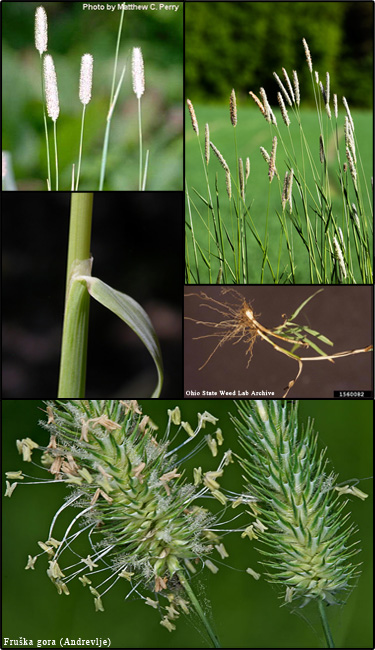Timothy (Phleum pratense)
 Common Names: Common timothy
Common Names: Common timothyDescription: Very useful for hay and cattle grazing.
Habit: Perennial, tufted grass from fibrous roots; stems usually enlarged and more or less bulbous at the base, grows up to 100 cm tall.
Leaves: Sheaths open, glabrous, ligules 2-3 mm long, entire, obtuse, blades flat, 4-8 mm broad, scabrous-margined.
Stems: (20) 50-150 cm, usually erect, lower internodes frequently enlarged or bulbous.
Flowers: Inflorescence, spike-like, cylindric panicle is 5-10 cm long, spikelets have 1-flower, strongly flattened, glumes 3-4 mm long with hairs on the keel, abruptly truncate and with a stout awn 1-1.5 mm long, lemmas pubescent, 2 mm long; the mid-nerve prolonged as a short bristle, paleas subequal to the lemmas, 2-nerved.
Fruit and seeds: Small, hard seeds, produces an abundant amount.
Habitat: Native to Eurasia. Found in pastures, mesic fields, roadsides, waste areas and disturbed sites.
Reproduction: By seed or vegetatively by tillering.
Similar species: Species of bristlegrass (Setaria spp.); species of Foxtail (Alopecurus spp.); and native Alpine timothy (Phleum alpinum).
Monitoring and rapid response: Hand-pulling; frequent cutting or mowing can weaken plant health. Credits: The information provided in this factsheet was gathered from the Burke Museum of Natural History and Culture, USDA PLANTS Database, U.S. Department of Agriculture, Forest Service and the University of British Columbia.
Individual species images that appear with a number in a black box are courtesy of the Bugwood.org network (http://www.invasive.org).Individual photo author credits may not be included due to the small display size of the images and subsequent difficulty of reading the provided text. All other images appear courtesy of Google (http://images.google.com).
